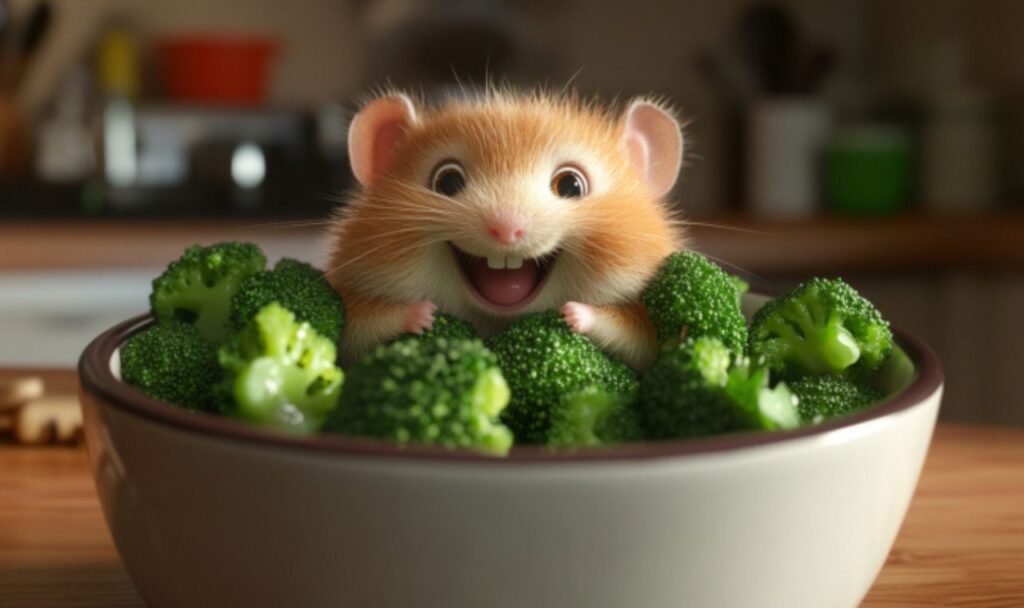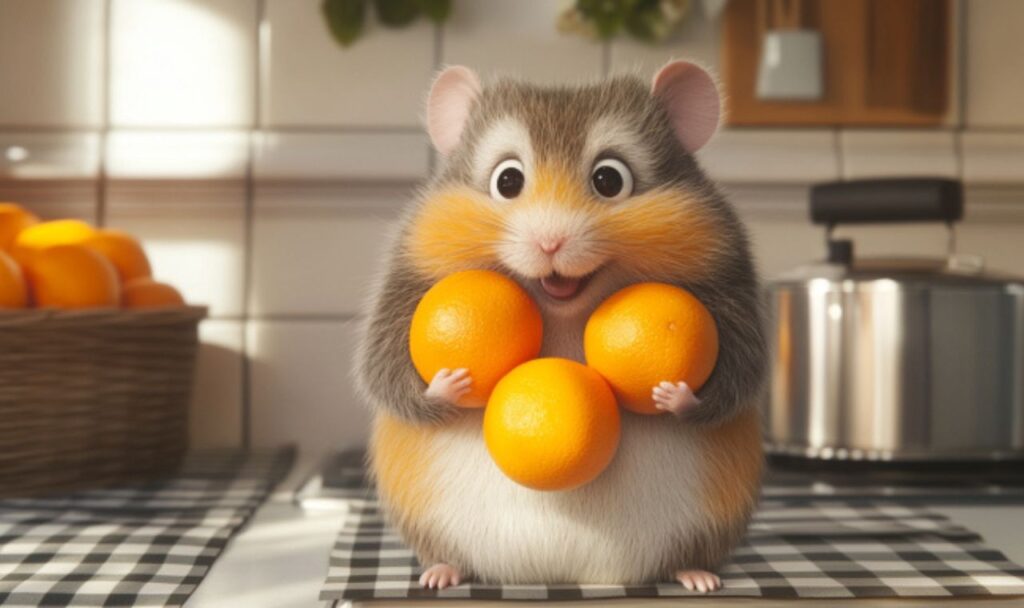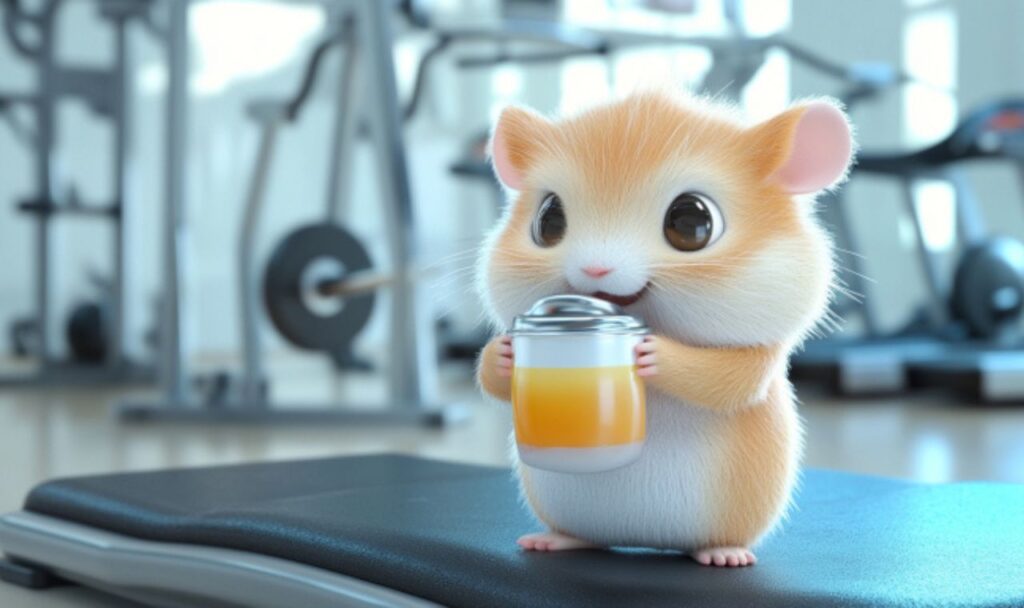When it comes to caring for your hamster, their diet is one of the most important aspects of their health and happiness. While standard hamster food provides essential nutrients, adding “superfoods” to their diet can give your furry friend an extra boost of vitamins, minerals, and antioxidants. But what exactly are superfoods for hamsters, and how can they help your tiny companion thrive?
Superfoods are nutrient-dense ingredients that provide numerous health benefits in small amounts. From seeds packed with healthy fats to fresh vegetables loaded with antioxidants, incorporating superfoods into your hamster’s diet can improve their energy, digestion, immunity, and even the shine of their coat! A well-rounded diet full of variety is the key to a happy and active hamster.
In this article, we’ll explore the best superfoods for hamsters, how to safely introduce them, and tips for creating a balanced, nutrient-rich meal plan. Ready to level up your hamster’s diet? Let’s dive in!
Brief Introduction to the Concept of Superfoods for Hamsters
Superfoods might sound trendy, but they’re not just for humans! In the context of hamsters, superfoods are simply ingredients that pack a nutritional punch. These foods are rich in vitamins, minerals, healthy fats, and other nutrients that support your hamster’s health in a big way, even in small portions.
While commercial hamster food mixes are designed to meet basic dietary needs, adding superfoods can help address specific health concerns and provide added variety. Plus, a few special treats now and then make meal times more exciting for your hamster!
Importance of a Nutrient-Rich Diet for Your Hamster’s Health
A balanced, nutrient-rich diet is vital for your hamster’s overall well-being. Just like humans, hamsters rely on a range of nutrients to keep their bodies functioning properly. Here’s why a high-quality diet is so important:
- Energy and Activity: Hamsters are naturally active creatures, especially at night. Proper nutrition keeps them energized for running, climbing, and foraging.
- Immune Support: Foods rich in antioxidants, vitamins, and minerals strengthen your hamster’s immune system, helping them fight off illnesses and infections.
- Coat and Skin Health: Omega-3 fatty acids, found in certain seeds, can keep their fur soft, shiny, and healthy.
- Digestive Health: Fiber-rich foods support their digestive system and prevent constipation.
By providing a diverse and nutrient-packed diet, you’ll not only keep your hamster healthy but also help them live a longer, happier life.
Teaser of What the Article Will Cover
Throughout this article, we’ll take a closer look at the top superfoods for hamsters and how they can benefit your furry friend’s health. We’ll explore:
- Seeds and Nuts: Tiny powerhouses of protein, healthy fats, and essential nutrients.
- Fresh Vegetables: Low-calorie, vitamin-packed options that boost hydration and support overall health.
- Fruits: Sweet treats loaded with vitamins and antioxidants (in moderation!).
- Protein-Rich Foods: Special additions like mealworms, eggs, and tofu to support muscle health and growth.
- Serving Tips: How to safely introduce superfoods, control portions, and maintain a balanced diet.
What Are Superfoods for Hamsters?

The term “superfood” might make you think of kale smoothies and chia pudding, but for hamsters, superfoods are simply ingredients that provide a concentrated dose of nutrients essential for their health. Adding these powerful foods to your hamster’s diet can improve their energy, coat health, digestion, and overall well-being. But what exactly qualifies as a superfood for hamsters, and how do you safely introduce them to your furry friend? Let’s break it down.
Defining Superfoods in the Context of Hamsters
What Makes a Food a “Superfood”?
A superfood is any food that is particularly rich in vitamins, minerals, antioxidants, healthy fats, or other nutrients that benefit your hamster’s health in a big way. These foods pack a powerful nutritional punch, meaning a small portion can provide a significant boost to your hamster’s diet.
For hamsters, common superfoods include seeds like flax or pumpkin seeds, fresh vegetables like broccoli or spinach, and protein-rich foods such as boiled egg or mealworms. These ingredients go beyond simply filling their bellies—they actively contribute to improved health and vitality.
Why Nutrient Density Matters for Hamsters
Hamsters are small animals with tiny stomachs, which means every bite of food matters. Nutrient-dense foods provide maximum benefits in minimal amounts, making them ideal for hamsters. For example, a single pumpkin seed is packed with protein, healthy fats, and micronutrients that support your hamster’s growth and overall health.
A nutrient-rich diet also helps prevent common health issues, such as obesity, digestive problems, and deficiencies in essential vitamins or minerals. Superfoods ensure that every nibble counts!
Differences Between Hamster Superfoods and Human Superfoods
While some superfoods for humans (like blueberries or spinach) overlap with hamster-friendly foods, others are a complete no-go for your tiny companion. Foods that are considered “super” for humans, such as dark chocolate or avocados, are toxic to hamsters.
Additionally, hamsters require different nutrients than humans. Their diet should prioritize high-quality proteins, healthy fats, and low-sugar foods. Always research hamster-safe options before offering any food, even if it’s considered healthy for humans.
The Benefits of Superfoods
Adding superfoods to your hamster’s diet can provide a variety of health benefits. Here are some of the key improvements you might notice:
Improved Digestion and Gut Health
Fiber-rich superfoods, such as leafy greens (spinach, kale) or oats, can help support your hamster’s digestive system. These foods prevent constipation and ensure smooth digestion, keeping your hamster active and comfortable.
Some seeds, like flaxseeds, also contain omega-3 fatty acids that reduce inflammation and promote a healthy gut.
Better Coat Quality and Overall Appearance
Superfoods like sunflower seeds, which are rich in vitamin E, and foods containing omega-3 fatty acids contribute to a shiny, soft coat and healthy skin. A nutrient-packed diet reduces the risk of dryness or patchy fur, keeping your hamster looking their best.
You’ll also notice that a healthy diet gives your hamster a bright, lively appearance, with clear eyes and an energetic demeanor.
Enhanced Energy Levels and Immunity
Superfoods provide your hamster with the fuel they need for their natural bursts of energy—whether that’s running on their wheel or exploring their habitat. Foods rich in vitamins (like broccoli and carrots) strengthen their immune system, helping them fight off infections and illnesses.
Incorporating these foods into their diet ensures your hamster is ready to take on the world—one tiny paw at a time!
How to Safely Introduce Superfoods
While superfoods can be a great addition to your hamster’s diet, introducing them requires care. Here’s how to make sure your hamster enjoys their new snacks safely.
Start Small: How to Test for Food Tolerance
When introducing any new food, always start with a small portion—about the size of your hamster’s paw. Hamsters have sensitive digestive systems, and new foods can sometimes cause upset stomachs or diarrhea. Offer a tiny piece and observe your hamster’s reaction over 24 hours.
If they show no signs of discomfort (such as loose stools or lethargy), you can gradually increase the portion size in future servings.
Rotating Foods for a Balanced Diet
Even superfoods should be offered in rotation rather than all at once. Feeding your hamster the same food too often can lead to boredom or even nutrient imbalances. For example, while spinach is healthy, it’s also high in calcium, which can cause bladder stones if overfed.
Create a meal plan that includes a mix of seeds, vegetables, fruits, and protein sources. Rotating foods ensures your hamster gets a variety of nutrients and keeps mealtime exciting.
Importance of Washing Fresh Produce to Remove Chemicals
Before serving any fresh produce, thoroughly wash it to remove pesticides, dirt, or other contaminants. Hamsters are particularly sensitive to chemicals, and even small amounts can harm their tiny bodies.
Opt for organic produce whenever possible, but even organic fruits and vegetables should be washed to ensure they’re safe for your hamster to eat.
Seeds and Nuts: Tiny Powerhouses

When it comes to hamster superfoods, seeds and nuts are some of the most nutrient-dense options available. These tiny powerhouses are rich in healthy fats, protein, vitamins, and minerals that can support your hamster’s energy levels, coat health, and overall well-being. However, because seeds and nuts are high in calories, they should be offered in moderation and served carefully. Let’s explore the best seeds and nuts for hamsters, which ones to avoid, and how to incorporate them into your furry friend’s diet safely.
Top Seeds for Hamsters
Seeds are an essential part of a hamster’s diet, providing energy, protein, and important nutrients. Here are some of the best seed options for your hamster:
Sunflower Seeds: A Tasty Treat in Moderation
Sunflower seeds are one of the most popular treats for hamsters—and for good reason! They’re tasty and packed with nutrients like healthy fats, vitamin E, and magnesium, which support your hamster’s skin, coat, and immune system.
However, sunflower seeds are high in fat, so they should be offered as an occasional treat rather than a staple food. Giving your hamster 1-2 sunflower seeds a few times a week is plenty to provide the benefits without contributing to weight gain.
Pumpkin Seeds: Packed with Healthy Fats and Protein
Pumpkin seeds are a fantastic addition to your hamster’s diet. These seeds are rich in healthy fats, protein, and essential minerals like zinc, which supports a healthy immune system. Pumpkin seeds also provide an energy boost, making them a great snack for active hamsters.
You can offer raw, unsalted pumpkin seeds either whole (for larger hamsters like Syrians) or shelled for smaller species, like dwarf hamsters. One or two seeds per week is sufficient.
Flaxseeds: A Great Source of Omega-3 Fatty Acids
Flaxseeds are a nutritional powerhouse for hamsters, providing omega-3 fatty acids that promote healthy fur, skin, and even brain function. These tiny seeds are also rich in fiber, which supports digestive health.
Because flaxseeds are so small, you can sprinkle a tiny pinch (about 1/8 teaspoon) over your hamster’s regular food once or twice a week. Be sure to offer raw, unprocessed flaxseeds to maximize their health benefits.
Which Nuts Are Safe?
While nuts can be a nutritious snack for hamsters, it’s important to choose the right types and serve them carefully. Here’s what you need to know:
Almonds (Unsalted, Unseasoned, and in Moderation)
Raw, unsalted almonds can be offered to hamsters in very small amounts as a treat. They’re a good source of protein, healthy fats, and vitamin E. However, it’s crucial to avoid sweetened, salted, or seasoned almonds, as these can be harmful to your hamster.
Limit almonds to a small piece (about the size of a hamster’s paw) once every week or two.
Walnuts: Healthy but Calorie-Dense
Walnuts are another safe nut option for hamsters, offering healthy fats and omega-3s that promote a shiny coat and energy. Like almonds, walnuts should be unsalted, unseasoned, and served in moderation due to their high calorie content.
Offer a small chunk (about the size of a pea) as an occasional treat. For dwarf hamsters, even smaller pieces are recommended.
Avoid Nuts That Are Salted or Flavored
While some nuts are safe for hamsters, avoid any that are salted, roasted with oil, or flavored (e.g., honey-coated or spiced). These additives can be toxic or lead to obesity, dehydration, or digestive upset. Additionally, steer clear of nuts that are toxic to hamsters, such as bitter almonds or macadamia nuts.
How to Serve Seeds and Nuts Safely
Seeds and nuts are healthy in moderation, but it’s important to serve them correctly to ensure your hamster gets the benefits without any risks.
Portion Sizes to Prevent Weight Gain
Because seeds and nuts are calorie-dense, portion control is key. Overfeeding can lead to weight gain or obesity, which increases the risk of other health problems.
- For Syrian hamsters, 2-3 small seeds or a small nut chunk (e.g., 1/4 of a walnut) per week is sufficient.
- For dwarf hamsters, offer even smaller amounts, such as a single pumpkin seed or a small pinch of flaxseeds.
Always adjust portions based on your hamster’s activity level and overall diet.
Choosing Unsalted, Raw Options
Always choose raw, unsalted, and unflavored seeds and nuts for your hamster. Processed options often contain harmful additives, such as salt, sugar, or oil, that can negatively impact your hamster’s health.
If possible, purchase seeds and nuts from a reputable pet store or a health food store that offers plain, untreated options.
Mixing Seeds into Their Regular Food for Variety
One of the easiest ways to serve seeds is by mixing them into your hamster’s regular food. This adds variety and keeps your hamster engaged during mealtime. For example:
- Sprinkle a pinch of flaxseeds over their commercial pellet mix.
- Add a sunflower or pumpkin seed to their daily food bowl as a little surprise.
Mixing seeds with their standard diet ensures that they’re still getting balanced nutrition while enjoying a treat.
Fresh Vegetables for Vital Nutrients

Fresh vegetables are a fantastic addition to your hamster’s diet, offering a wide range of vitamins, minerals, antioxidants, and hydration. These nutrient-packed foods help support your hamster’s immune system, keep their digestive health in check, and promote overall well-being. However, not all vegetables are safe for hamsters, and it’s crucial to know which ones to include—and which to avoid. Let’s explore the best hamster-safe veggies, the ones you should steer clear of, and tips for safely serving vegetables to your furry friend.
Hamster-Safe Vegetables to Include
Incorporating fresh vegetables into your hamster’s diet is an excellent way to boost their nutrition. Here are some of the top veggies to include:
Cucumber: Hydrating and Low in Calories
Cucumber is one of the best vegetables you can offer your hamster, especially during hot weather. It’s hydrating, low in calories, and gentle on their digestive system. This makes it a great snack for hamsters of all sizes and ages.
Serve a thin slice or a small, bite-sized piece of cucumber once or twice a week. Be sure to remove the skin if it’s not organic, as it may contain pesticides.
Broccoli: High in Vitamins and Antioxidants
Broccoli is a nutrient-rich vegetable packed with vitamin C, vitamin K, and antioxidants that support your hamster’s immune system. It also contains fiber, which aids in digestion. Many hamsters enjoy the crunchy texture of raw broccoli, but you can also lightly steam it if needed.
Offer a small floret or a piece about the size of your hamster’s paw once or twice a week. Avoid overfeeding broccoli, as it can cause gas if given in excess.
Carrots: Sweet and Rich in Beta-Carotene
Carrots are a sweet, colorful treat loaded with beta-carotene, a nutrient that promotes healthy skin and eye function. Their natural sweetness makes them especially appealing to hamsters, but they should be given in moderation to avoid excess sugar.
A small slice or a chunk the size of your hamster’s paw is enough for one serving. Offer carrots no more than once or twice a week as part of a balanced diet.
Vegetables to Avoid
While many vegetables are safe for hamsters, some can be harmful or even toxic. Avoid the following vegetables to keep your hamster safe:
Onions, Garlic, and Leeks: Toxic for Hamsters
These vegetables belong to the allium family and contain compounds that are toxic to hamsters. They can cause anemia and digestive upset, even in small amounts. Never offer your hamster onions, garlic, or leeks.
Potatoes: Can Cause Digestive Issues
Raw potatoes are high in starch, which can be difficult for hamsters to digest. They also contain solanine, a compound that can be toxic. Even cooked potatoes should be avoided, as they offer little nutritional value and can contribute to weight gain.
Rhubarb: Dangerous and Potentially Fatal
Rhubarb contains oxalic acid, which is highly toxic to hamsters. Consuming even a small amount can lead to severe health issues, including kidney damage and potentially death. Avoid rhubarb entirely, including its leaves and stems.
When in doubt about a vegetable’s safety, always research before offering it to your hamster. It’s better to be cautious than to risk their health.
Tips for Serving Vegetables
To ensure your hamster enjoys the benefits of fresh vegetables safely, follow these serving tips:
Offer Small, Bite-Sized Portions
Hamsters have tiny stomachs, so small portions are all they need. A piece of vegetable about the size of your hamster’s paw is usually sufficient. Overfeeding vegetables can lead to digestive upset, so keep portions small and occasional.
For dwarf hamsters, consider offering even smaller pieces to avoid overwhelming their tiny appetites.
Remove Uneaten Pieces to Prevent Spoilage
Fresh vegetables can spoil quickly, especially in a warm cage. Always remove any uneaten pieces within a few hours to prevent mold or bacteria from growing. Spoiled food can cause illness if your hamster accidentally eats it later.
A good practice is to give vegetables in the evening (when your hamster is most active) and check their cage in the morning for leftovers.
Rotate Veggies for Variety and a Balanced Nutrient Profile
No single vegetable provides all the nutrients your hamster needs, so offering a variety is key. Rotate different veggies throughout the week to ensure a balanced nutrient profile. For example:
- Monday: A small piece of cucumber.
- Wednesday: A tiny floret of broccoli.
- Friday: A slice of carrot.
This rotation not only keeps your hamster’s diet interesting but also helps prevent overfeeding any one vegetable, reducing the risk of imbalances or digestive issues.
Fruits: A Sweet Treat Packed with Vitamins

Fruits can be a delightful and nutritious addition to your hamster’s diet. They’re packed with vitamins, antioxidants, and hydration, making them the perfect occasional treat for your furry friend. However, because many fruits are high in natural sugars, they must be served sparingly to avoid health problems like obesity or diabetes—especially in dwarf hamster breeds, which are more prone to these conditions. By offering the right fruits in moderation and avoiding harmful ones, you can add a healthy dose of variety and enjoyment to your hamster’s diet.
Hamster-Safe Fruits to Try
Adding hamster-safe fruits to your pet’s diet is a great way to provide a boost of vitamins and antioxidants. Here are some of the best fruit options to include:
Apples (Seedless): A Crunchy, Vitamin-Rich Option
Apples are an excellent snack for hamsters because they’re loaded with fiber and vitamin C while being low in calories. Their crunchy texture also makes them fun for hamsters to nibble on, helping to keep their teeth healthy.
Make sure to remove the seeds before serving, as apple seeds contain cyanide, which is toxic to hamsters. Offer a small piece of apple, about the size of your hamster’s paw, as an occasional treat.
Blueberries: Tiny and Antioxidant-Packed
Blueberries are a superfood not just for humans, but for hamsters as well! These tiny, nutrient-dense fruits are packed with antioxidants that help protect cells and boost the immune system. They’re also easy for hamsters to handle and eat because of their small size.
Give your hamster one or two blueberries at a time, no more than once or twice a week. Avoid overfeeding, as the natural sugars in blueberries can add up quickly.
Strawberries: Sweet, Hydrating, and Nutrient-Rich
Strawberries are another hamster-safe fruit that’s rich in vitamin C and hydration. Their natural sweetness makes them a favorite among hamsters, and their water content helps keep your furry friend hydrated.
Offer a small piece of strawberry (about half the size of their paw) as an occasional treat. Be sure to wash strawberries thoroughly to remove any pesticide residue, and remove the stem and leaves before serving.
Fruits to Avoid
Not all fruits are safe for hamsters, and some can be harmful or even toxic. Here’s a list of fruits to steer clear of:
Citrus Fruits Like Oranges and Lemons: Too Acidic for Hamsters
Citrus fruits, such as oranges, lemons, limes, and grapefruits, are highly acidic and can cause digestive upset and mouth irritation in hamsters. Even a small amount of citrus can be too harsh for their sensitive stomachs.
Avoid all citrus fruits entirely, even in tiny amounts.
Grapes and Raisins: Toxic to Many Small Animals
Grapes and raisins are known to be toxic to many small animals, including hamsters. They can cause kidney failure and other serious health issues, so they should never be included in your hamster’s diet.
Even if your hamster seems interested in grapes or raisins, it’s best to avoid them completely to ensure their safety.
Sugary or Dried Fruits: Best Avoided to Prevent Diabetes
While fresh fruits can be a healthy treat, dried fruits like raisins, dried apricots, and candied fruits should be avoided. They are highly concentrated in sugar, which can contribute to obesity and diabetes in hamsters—especially dwarf species like Roborovski and Campbell’s hamsters, which are more prone to metabolic disorders.
Stick to fresh, natural fruits to keep your hamster healthy and safe.
How to Keep Fruit Treats Healthy
Even hamster-safe fruits should be served carefully to ensure they provide maximum benefits without causing any issues. Follow these tips to keep fruit treats healthy:
Limit Servings to Avoid Overloading on Sugar
Although fruits are rich in nutrients, they are also high in natural sugars, which can lead to weight gain and other health issues if overfed. For this reason, fruits should only make up a small part of your hamster’s diet.
Offer fruit no more than once or twice a week and stick to tiny portions. For example, a single blueberry or a small chunk of apple is enough for one serving.
Only Offer Fresh, Unsweetened Fruits
Always serve fresh, raw fruits without any added sugar, syrups, or flavors. Avoid canned fruits, which are often preserved in sugary syrups, and never give your hamster processed fruit products like jams or fruit snacks.
Fresh, natural fruits are the healthiest and safest option for your pet.
Introduce One Fruit at a Time to Monitor for Allergies
When introducing a new fruit, offer only one type at a time and monitor your hamster’s reaction for 24-48 hours. Look for signs of digestive upset, such as diarrhea, or behavioral changes like lethargy. If your hamster shows any negative reaction, stop offering that fruit immediately.
This cautious approach helps you identify any potential allergies or sensitivities and ensures your hamster’s safety.
Protein and Special Boosters

Protein is a critical component of your hamster’s diet, providing the energy and building blocks they need for growth, muscle maintenance, and overall health. While commercial hamster food typically contains some protein, supplementing with additional protein-rich foods and nutrient-packed boosters can elevate your hamster’s health to the next level. However, these “special boosters” should be carefully balanced to avoid overfeeding or nutritional imbalances. In this section, we’ll dive into the best protein sources, unique superfoods, and how to incorporate them into your hamster’s diet safely and effectively.
Protein-Rich Foods for Hamsters
Protein is essential for your hamster’s overall health and well-being. Here are some of the best protein-rich options to include in their diet:
Cooked Eggs: A Great Source of Protein in Small Amounts
Cooked eggs are one of the best sources of high-quality protein for hamsters. They also contain essential vitamins and minerals like vitamin B12, riboflavin, and selenium. Hamsters particularly enjoy the soft texture of scrambled or hard-boiled eggs.
Offer your hamster a small piece of cooked egg, about the size of a pea, no more than once or twice a week. Avoid seasoning the egg, as salt and spices can be harmful.
Mealworms: A Favorite for Extra Protein
Mealworms are a natural, high-protein snack that hamsters absolutely love. They’re particularly beneficial for active hamsters or those that need an extra protein boost, such as pregnant or nursing females. Mealworms are also a great way to mimic a hamster’s natural diet in the wild, as they would occasionally consume insects.
Serve 1-2 dried or live mealworms as a treat once or twice a week. Be sure to purchase mealworms from a pet store to ensure they’re safe and free of pesticides.
Plain Tofu: A Plant-Based Option for Protein Variety
If you’re looking for a plant-based protein source, plain tofu is an excellent option. It’s soft, easy for hamsters to eat, and rich in protein and calcium. Tofu is especially useful for hamsters that may not enjoy animal-based protein options.
Offer a small cube of plain, unseasoned tofu (about the size of your hamster’s paw) once a week. Make sure the tofu is fresh and hasn’t been flavored or processed with additives.
Superfoods with Unique Benefits
In addition to protein, certain superfoods can provide unique nutritional benefits to enhance your hamster’s overall health. Here are a few to consider:
Kale: High in Calcium and Antioxidants
Kale is a leafy green powerhouse packed with calcium, vitamin C, and antioxidants. It supports strong bones, boosts the immune system, and helps reduce inflammation. However, kale should be fed in moderation, as too much calcium can lead to bladder stones.
Serve a small leaf or a piece the size of your hamster’s paw once every week or two. Wash the kale thoroughly to remove any pesticides.
Spinach: Great for Vitamin C and Iron (in Small Amounts)
Spinach is another nutrient-rich green that’s high in vitamin C and iron. These nutrients help support your hamster’s immune system and energy levels. Like kale, spinach should be fed in moderation to avoid excessive calcium intake.
Offer a small piece of fresh spinach (about the size of your hamster’s paw) once a week. Always wash it well to remove any traces of chemicals or dirt.
Oats: Good for Energy and Digestion
Oats are a fantastic source of energy and fiber, making them a great addition to your hamster’s diet. They help regulate digestion and provide a slow release of energy to keep your hamster active throughout the day.
Sprinkle a small pinch of plain, uncooked oats into their regular food mix once a week. Avoid flavored or sweetened oats, as these can contain harmful additives.
Treats vs. Staples: How to Balance
While protein-rich foods and superfoods can greatly benefit your hamster, it’s important to balance these additions with their regular diet to avoid overfeeding or nutritional imbalances.
Using Superfoods as Occasional Treats, Not the Main Diet
Superfoods and protein boosters should complement your hamster’s main diet, not replace it. The bulk of your hamster’s nutrition should come from a high-quality commercial food mix designed specifically for hamsters.
Think of superfoods like cooked eggs, kale, and mealworms as occasional treats that provide variety and enrichment. For most hamsters, offering a superfood snack 2-3 times a week is plenty.
Monitoring Your Hamster’s Weight and Health
It’s essential to monitor your hamster’s weight and overall health when adding new foods to their diet. Overfeeding high-calorie items like mealworms or oats can lead to obesity, which increases the risk of other health issues.
Watch for signs of a healthy weight, such as an active, energetic hamster with a sleek coat. If you notice your hamster gaining too much weight, scale back on treats and focus on portion control.
Balancing Superfoods with Commercial Hamster Food for a Complete Diet
The key to a healthy hamster is balance. Combine the nutrients from protein-rich foods and superfoods with the base nutrition provided by a commercial hamster mix. Commercial food ensures your hamster gets essential nutrients like fiber, vitamins, and minerals, while superfoods add variety and targeted benefits.
For example:
- Base Diet: High-quality hamster pellets or seed mix (80-90% of the diet).
- Superfoods and Treats: Protein boosters (e.g., mealworms or eggs) and greens (e.g., kale or spinach) offered 2-3 times per week (10-20% of the diet).
Conclusion: Building a Superfood-Powered Diet

Hamsters may be small, but their nutritional needs are just as important as those of larger pets. Incorporating superfoods into their diet is a great way to ensure your furry friend stays healthy, energetic, and happy. By choosing the right combination of nutrient-packed foods, you can give your hamster a diet that not only meets their basic needs but also boosts their overall well-being.
From protein-rich foods like cooked eggs and mealworms to antioxidant-packed greens like kale and spinach, superfoods can bring incredible benefits to your hamster. Let’s recap what we’ve learned about building a superfood-powered diet for your tiny companion.
Recap of the Best Superfoods for Hamsters and Their Benefits
Throughout this guide, we’ve explored a variety of superfoods and how they can contribute to your hamster’s health:
- Seeds and Nuts: Pumpkin seeds, sunflower seeds, and flaxseeds are packed with healthy fats, protein, and nutrients that support energy, coat health, and immunity.
- Fresh Vegetables: Cucumber, broccoli, and carrots provide hydration, vitamins, and antioxidants that promote digestive health, immunity, and a shiny coat.
- Fruits: Apples (seedless), blueberries, and strawberries are sweet treats that add a boost of vitamins and hydration but should be offered in moderation due to their natural sugar content.
- Protein Boosters: Cooked eggs, mealworms, and tofu are excellent sources of protein that support muscle maintenance and energy.
- Special Boosters: Greens like kale and spinach are rich in vitamins and antioxidants, while oats provide fiber and energy for an active lifestyle.
These superfoods work together to improve digestion, strengthen immunity, enhance energy levels, and even maintain the health of your hamster’s fur and skin. Each food has its own unique benefits, and when combined with a high-quality commercial hamster mix, they create a complete and balanced diet.
Encouragement to Provide Variety and Balance for Optimal Health
One of the keys to a healthy diet is variety. Hamsters thrive on a mix of flavors, textures, and nutrients, which mimic the variety they would experience in the wild. By rotating different superfoods in their diet, you’ll not only keep them engaged at mealtime but also ensure they receive a diverse range of nutrients.
For example, you might offer a small piece of broccoli on one day, a tiny chunk of apple later in the week, and a mealworm on the weekend. This variety keeps things exciting for your hamster while preventing nutrient imbalances from overfeeding any single food.
Remember that balance is essential. Superfoods are meant to complement your hamster’s main diet of pellets or seed mixes, not replace it. A high-quality commercial food should make up the majority of their diet, with superfoods as occasional additions to provide extra benefits.
Reminder to Monitor Portion Sizes and Always Research Before Introducing New Foods
While superfoods are highly beneficial, portion control is critical to prevent overfeeding or health issues like obesity, digestive upset, or nutrient imbalances. Hamsters have tiny stomachs, so a little goes a long way. As a general rule:
- Seeds and nuts: 1-2 small seeds or a tiny nut chunk per week.
- Vegetables and fruits: A piece the size of your hamster’s paw, no more than 2-3 times per week.
- Protein boosters: Small amounts (e.g., a pea-sized piece of egg or 1-2 mealworms) once or twice a week.
It’s also important to research any new food before introducing it to your hamster. Some foods that are healthy for humans or other pets can be toxic to hamsters. When trying something new, offer a small portion and monitor your hamster’s reaction for 24-48 hours to ensure they tolerate it well.




